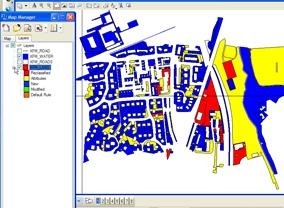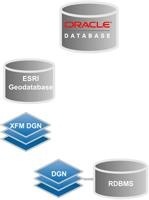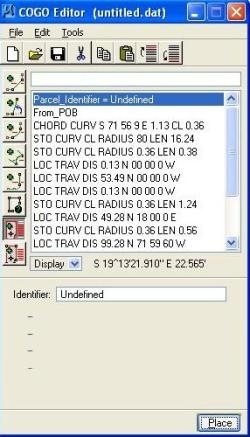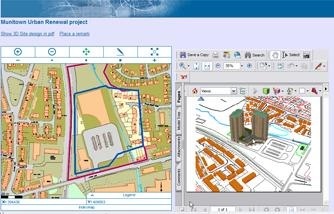
Bentley Cadastre is a special application built on Bentley Map from the XM V8.9 version and as its name implies, it is for this task, the Cadastre. Bentley Map is required for its operation, and it is equivalent to a controlled cadastral maintenance module.
Priority focus of this application is the topology integration, a property got out from the moment when geometries could be within a database. From there a territorial object can understand if another is its neighbor, if they share boundaries, if they  overlap and even if it contains an object inside that constitutes a hole.
overlap and even if it contains an object inside that constitutes a hole.
With this, Bentley did not leave the criticized stubbornness of Lemmen models who insist on using centroids (nodes) and regions (boundaries), as it also appears in the first ArcInfo coverage’s. Although they are very good and deep studies (smokes), Geographics was unable to handle complex geometries such as a property inside another one; because it covert them into a cell making impossible its spatial analysis. They are called complex geometries but are very common in cadastre, none in cartography.
 From MicroStation version 8.5, technology known as XFM, is implemented where an xml structure keeps stored tabular data defined in schema, and then map can have information required in an accompanying table. The schema can also be configured so that it can only see data from the external database and this is only the interface to feed them, edit them, or simply view them.
From MicroStation version 8.5, technology known as XFM, is implemented where an xml structure keeps stored tabular data defined in schema, and then map can have information required in an accompanying table. The schema can also be configured so that it can only see data from the external database and this is only the interface to feed them, edit them, or simply view them.
Bentley Cadastre multi-layer architecture is very robust, even is intended to interact not only with products within a Bentley Map project. It supports development under these connections:
- Oracle Spatial, two up to three layers
- ArcGIS, three layers
Of course, has full integration with XFM projects in dgn formats and connects to any RDBMS/DGN supported by MicroStation.
MicroStation Geographics Constraints
One of the major disadvantages of spatial cartridge was that the topological standards configuration was complicated. In addition it consumes all the servers’ resources because CAD’s high precision complicates spatial analysis or a simple database query.
Because of this difficulty in topology at database level, topological analysis tools in memory were used. One of the disadvantages was the rigor’s extremes that had (and have?) Geographics, because topological cleaning was necessary to take it to ends of 0.00001 dangles and segment so as to keep consistent layers affectation or  theming in the Publisher vpr.
theming in the Publisher vpr.
These details were absurd considering that a building does not require measurements of less than a millimeter. And what about integrity among reference files… that required not only sharing boundaries but also nodes or geometries which were not recognized when you create a topological layer.
Topology Implementation
Bentley Cadastre implements topology in three types of geometries, managing Node feature names (point), boundary feature (closed region) and Parcel Feature (polygon). While the Parcel concept is implemented (similar to AutoCAD Map), you can see that Bentley maintains its insistence on the Boundary/node criterion by adding the Boundary/label option that is now dynamic in regard to the geometry that represents. This emphasis may be noted in the tools that keep topological control on the fly:
- Parcel feature: Only in the stretch
- Boundary feature: move, scale, rotate, align edges, parallel, move to contact, modify, extend, trim, insert vertex, delete vertex, fillet, chamfer
- Node feature: move, scale, rotate, align edges, parallel, move to contact
So it is possible to configure topology rules inside of the database (only mentioned Oracle Spatial) so that when building new sites or doing (maintenance) conservation, alerts are enabled to make the respective changes or the system makes the auto setting.
Implements tools for cadastral use
One of the best advantages of Bentley Cadastre is geared to what happens in the process of construction, administration and cadastral maintenance from the geometric aspect for what it has been built specific buttons.
In fact these aren’t actions that could not be done with MicroStation Geographics, but what has been implemented is the xfm technology and automation that most times had to be done only with Project Wise and Vba.
Also, it has been added xfm capabilities to the most common commands for building and editing data in order to customize them for land registry use. Finally cogo-compatible tools give them greater customization.
Creation of topologies, all of these involve an AutoUpdate area, the coordinates of the bounding box containing the geometry and its perimeter… it’s clear that with customization, using Geospatial Administrator, it could also update another data type such as a warning if it requires the appraisal inspection, if you send marginal annotation to the land registry, or the Association to a Project Wise workflow etc.

- Create node
- Create boundary
- Rectangular Mapping
- Radial Mapping
- Linear Adjustment
- Fillet radial to the extreme
- Project a boundary to a node
- Auto numbering
- Grouping Plots
- Exporting plots to working lines
- Building topology from nodes
- Building topology from working lines
- Cogo editor
Topologies Maintenance
- Dismember, this has several interesting features among which it includes irregular parcels partition from a base line that can be divided into equal parts. It can also be searched a specific area with an orientation line.
- Group, with this it can be grouped one or more parcels, the process can be configured so that the new site retains the cadastral key of the residual area or it can be generated a new one.
- Modify, this is in the case of moving a boundary while preserving the topological integrity on the fly.
Implement it is more easy than migrate
In another post we’ll discuss this in depth; because deployment is as simple as build it from scratch but migrating a complex project from Geographics to Bentley Map should not be so simple for reasons such as these:
-Geographics objects could have multiple features, go to Bentley Map would require separate those features in separate objects and create them topological integrity rules.
-The dgn objects usually exploited the historical archive to store their mutations there… and these would go to hell as there isn’t some tool to bring them to a tabular database.
-The vba tools built to automate carpentry: register maps, link farms, calculate apc (area, perimeter, coordinates), renumbering, topological analysis… etc, must be adjusted because everything they did is brought now in buttons.
-Control via Project Wise, was just to give the right to check out on discrete files, to reduce the size of the files. In this case all of that control must be rebuilt to create  access to territorial objects individually.
access to territorial objects individually.
– The developing of online maintenance request applications which sent the geometry as a redline file… It’s better not to continue.
Bentley Cadastre Perspectives
Bentley Cadastre seems to be a Bentley Map breakthrough, however the fact that ensured that both XM and V8 would be provisional, made many of us await the promised V8i land hoping it won’t be necessary to make the investment in migrating twice. Also we see the downside of staying out of data services that are taking good reception as Postgre, tool that many have seen favorably after an Oracle license for a big land project can go by $ 30,000 per year only for a two-processor server data services.
Deploying Bentley Systems technologies is often something that experts recommend for cadastral projects at country level or big regions; however it would be interesting to measure whether this fondness for the dgn associated with territory is associated to its ingenious technology which allows calling 15 orthophotos plus 15,000 sites, and after 10 seconds view results in flight. Or beyond that it is also available the disposition to philosophize (egeomate) to the sublime with  applications that are very powerful but not always very digestible for the average user, this is the case of Bentley Geospatial Server, Project Wise and Geoweb Publisher that are necessary to implement Bentley Cadastre.
applications that are very powerful but not always very digestible for the average user, this is the case of Bentley Geospatial Server, Project Wise and Geoweb Publisher that are necessary to implement Bentley Cadastre.
Site: Bentley Cadastre
 Autocad Software, Bentley Microstation, Gis Google Earth, Gis System Geomate Provides Services For Complete Gis Software And Solutions, Autocad Software, Autocad Courses, Bentley Microstation, Microstation Software, Gis Google Earth, Open Source Gis And More.
Autocad Software, Bentley Microstation, Gis Google Earth, Gis System Geomate Provides Services For Complete Gis Software And Solutions, Autocad Software, Autocad Courses, Bentley Microstation, Microstation Software, Gis Google Earth, Open Source Gis And More.